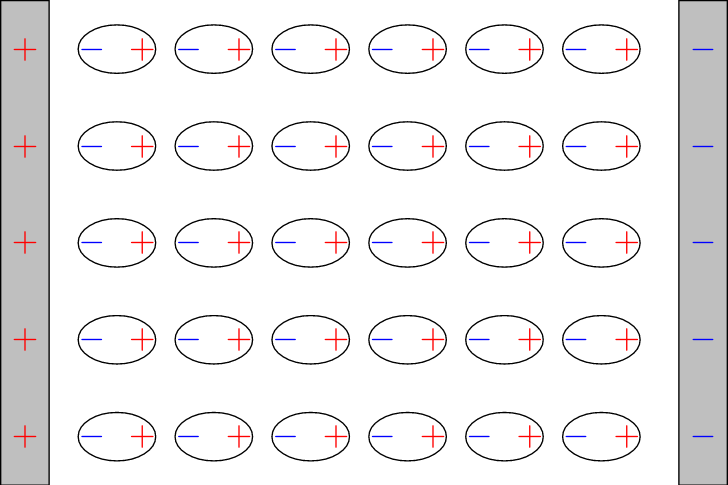Dielectrics
We have already seen that electrons in metals are fully movable. If a conductor is placed inside an electric field, these charges are moving until the outer electric field is fully compensated by the charges inside the conductor. We will see now in the following that for isolators a similar observation can be made when placing them inside an electric field. If an electric isolator is positioned between the plates of an already charged capacitor, the measured voltage drops. The reason for this behavior is the fact that the electrons in this material move slightly to the positively charged electrode. This is illustrated in the following figure where an isolator is placed between two parallel charged plates. In contrast to a conductor, this movement is not complete which results in the creation of dipoles in that material. The electric field of these dipoles is then compensating for the electric field of the capacitor up to a certain amount $\varepsilon$. This can be written as $$E = \frac{E_0}{\varepsilon}$$ Here, $E_0$ denotes the electric field in vacuum or approximately in air and $\varepsilon$ is called dielectric constant or permittivity. Coulomb's law for point-like charges in a medium can then be written as $$\vec{F}_\mathrm{C} = \frac{Qq}{4\pi \varepsilon_0\varepsilon r^2}\hat{\vec{r}}$$ Since the charge $Q$ on the surfaces of the metal plates remains the same, this process results in the increase of the capacitance $C_0$ of the capacitor with a vacuum between its plates by $\varepsilon$: $$\boxed{C = \varepsilon C_0}$$ Using this relation, the capacitance of a plate capacitor for instance can be written as $$C = \varepsilon_0\varepsilon\frac{A}{d}$$ As one can see, electrostatic induction and polarisation are very similar to each other. The only difference is that in the case of induction, the movement of the charges inside a conductor fully compensates for the electric field, whereas polarisation can only lead to a more or less strong decrease in the electric field. Isolating materials with a high value of $\varepsilon$ are called dielectric materials. The following table gives an overview of some important dielectric constants.| Material | Dielectric Constant |
| Fused Silica | 3.75 |
| TiO2 | 80 |
| Water | 81 |
| Air | 1.000576 |
This page contains 523 words and 3292 characters.
Last modified: 2022-10-01 18:37:01 by mustafa



